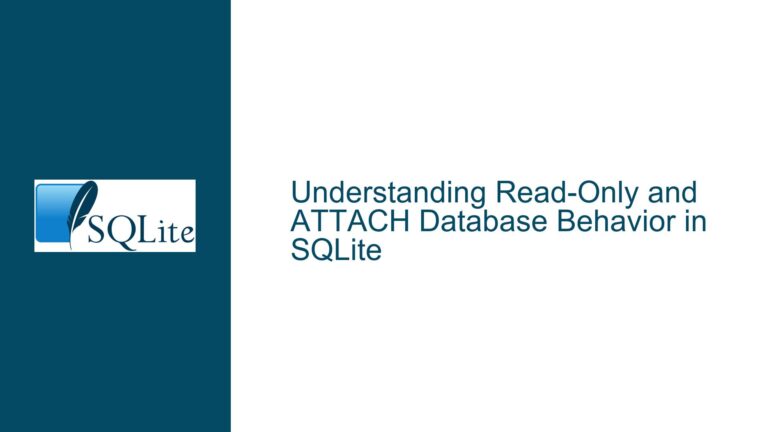Foreign Key Constraint Not Enforcing ON DELETE SET NULL Due to Disabled PRAGMA
Issue Overview: Foreign Key Action Not Triggering After DELETE Operation
When executing a DELETE operation on a parent table row, the expected ON DELETE SET NULL behavior on a child table’s foreign key column may fail to trigger, leaving orphaned references or inconsistent data. This issue arises when a database schema includes foreign key constraints with specific actions (e.g., ON DELETE SET NULL) and triggers designed to propagate deletions across related tables.
Consider a scenario with two tables:
- Table A (
id INTEGER PRIMARY KEY, data INTEGER) - Table B (
id INTEGER PRIMARY KEY, aRef INTEGER REFERENCES A ON DELETE SET NULL)
A trigger B_Trigger is defined to delete rows in Table A when corresponding rows in Table B are deleted:
CREATE TRIGGER B_Trigger AFTER DELETE ON B
FOR EACH ROW
BEGIN
DELETE FROM A WHERE id = OLD.aRef;
END;
After inserting data into both tables and deleting a row from Table B, the foreign key column aRef in remaining Table B rows referencing the same Table A row does not update to NULL as expected. For example:
INSERT INTO A (data) VALUES (10); -- A.id = 1
INSERT INTO B (aRef) VALUES (1); -- B.id = 1
INSERT INTO B (aRef) VALUES (1); -- B.id = 2
DELETE FROM B WHERE id = 1;
SELECT * FROM B; -- Returns (2, 1) instead of (2, NULL)
The foreign key constraint’s ON DELETE SET NULL action does not execute, resulting in Table B retaining a reference to a deleted Table A row. The root cause lies in SQLite’s configuration and the interaction between triggers and foreign key enforcement mechanisms.
Possible Causes: Disabled Foreign Key Enforcement and Connection-Specific Settings
1. Foreign Key Support Not Enabled
SQLite disables foreign key constraint enforcement by default. The PRAGMA foreign_keys setting must be explicitly enabled per database connection to activate ON DELETE and ON UPDATE actions. If this setting is off, foreign key constraints are ignored, and actions like SET NULL or CASCADE will not execute.
2. Connection-Specific Configuration
Foreign key enforcement is a connection-level setting. Each new connection to the database resets this configuration to the compile-time default (typically OFF). Applications or tools that open multiple connections (even sequentially) must re-enable foreign keys every time a connection is established.
3. Trigger Execution Order and Side Effects
Triggers operate independently of foreign key constraints. In this scenario, B_Trigger deletes the referenced Table A row after the DELETE operation on Table B. However, if foreign keys are disabled:
- The DELETE on Table B does not trigger the ON DELETE SET NULL action (since foreign keys are off).
- The trigger’s DELETE on Table A does not propagate changes to Table B (no foreign key enforcement).
Even with recursive triggers enabled, foreign key constraints and triggers execute in separate phases. The absence of foreign key enforcement breaks the expected chain of actions.
Troubleshooting Steps, Solutions & Fixes
Step 1: Enable Foreign Key Enforcement
Explicitly enable foreign keys for every database connection:
PRAGMA foreign_keys = ON;
Verify the setting:
PRAGMA foreign_keys; -- Returns 1 if enabled
Why This Matters: Foreign key constraints are inert unless this PRAGMA is set. Applications must enable it during connection initialization.
Step 2: Validate Connection-Specific Settings
Ensure foreign keys are enabled in all application components and tools. Common pitfalls include:
- Database browsers (e.g., DB Browser for SQLite) not enabling foreign keys by default.
- ORM frameworks requiring explicit configuration to send
PRAGMA foreign_keys = ONupon connection. - Scripts or services that reopen connections without reapplying the PRAGMA.
Step 3: Analyze Trigger-Foreign Key Interactions
With foreign keys enabled, the sequence of operations becomes:
- DELETE from Table B (id=1).
- Table B’s trigger fires, deleting the Table A row (id=1).
- The DELETE from Table A activates the ON DELETE SET NULL action on Table B, setting
aReftoNULLfor all rows referencingA.id = 1.
Revised Test Case:
PRAGMA foreign_keys = ON;
-- Recreate tables and trigger
DELETE FROM B WHERE id = 1;
SELECT * FROM B; -- Returns (2, NULL)
Step 4: Handle Cross-Connection Configuration
Implement a connection lifecycle management strategy:
- Application Code: Execute
PRAGMA foreign_keys = ONimmediately after opening a connection. - ORM Configuration: Use hooks or settings to enforce the PRAGMA (e.g., SQLAlchemy’s
event.listenfor SQLite). - Tooling: Configure database browsers or CLI tools to enable foreign keys automatically.
Step 5: Debugging Orphaned References
If aRef remains non-NULL after deletions:
- Confirm foreign keys are enabled in the active connection.
- Check for
AFTER DELETEtriggers on Table A that might interfere with foreign key actions. - Use SQLite’s
PRAGMA foreign_key_checkto identify constraint violations.
Step 6: Schema and Trigger Redesign (Advanced)
If the ON DELETE SET NULL behavior is insufficient, consider:
- Replacing the trigger with a foreign key ON DELETE CASCADE (requires schema changes).
- Using a
BEFORE DELETEtrigger to manually setaReftoNULLbefore deleting Table A.
Final Solution:
Enabling foreign keys and ensuring consistent configuration across all connections resolves the ON DELETE SET NULL failure. The trigger and foreign key constraint work in tandem only when SQLite’s foreign key enforcement is active.






